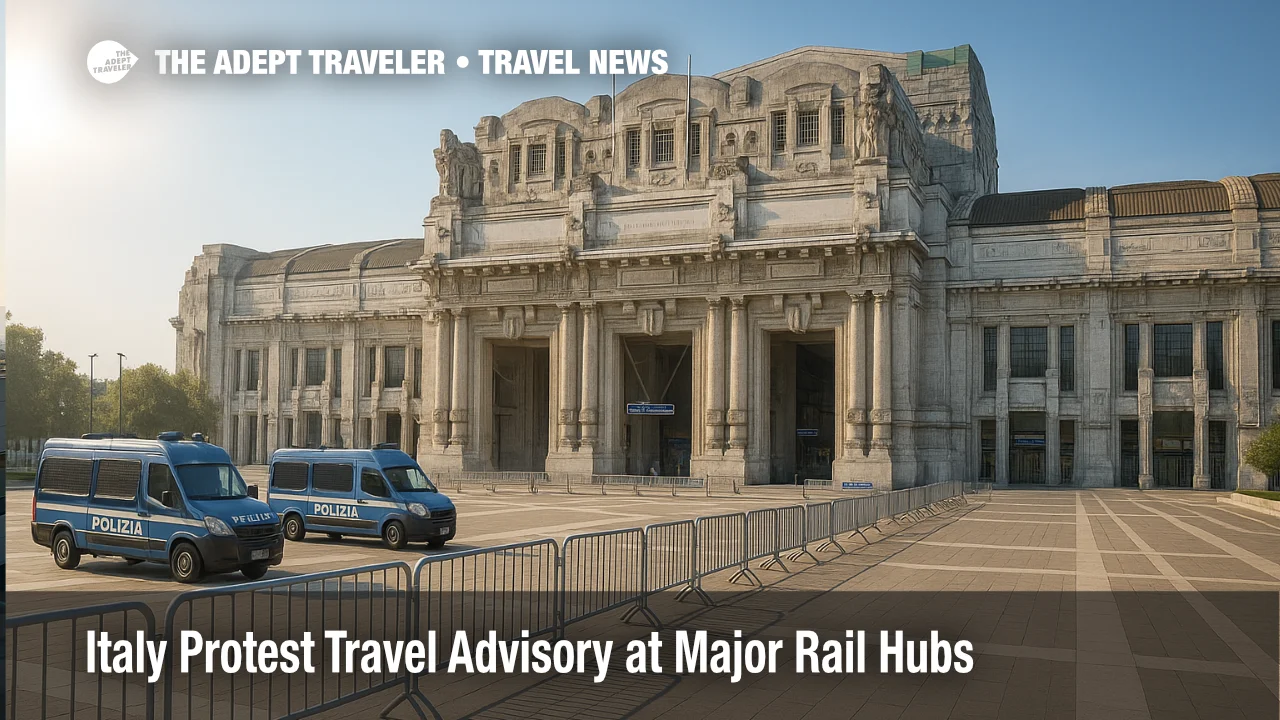Italy protest travel advisory at major rail hubs

Travelers moving through Italy's biggest rail stations face potential delays after authorities warned of flash demonstrations near Milano Centrale and other hubs following large actions on September 22. The U.S. Embassy in Italy advised travelers to monitor local media, avoid crowds, and expect intermittent disruption as police manage pop-up marches that could spill into station forecourts and concourses. While trains continue to operate, brief access restrictions and rerouting are possible around protest activity, particularly at peak hours.
Key points
- Why it matters: Flash protests can quickly block entrances and concourses, delaying departures and connections.
- Travel impact: Expect ad-hoc police cordons, redirected foot traffic, and slower security lines at major stations.
- What's next: Authorities signal continued demonstrations; travelers should allow extra time through October.
- Keep tickets handy, monitor rail apps, and use alternate entrances where signed.
- Consider flexible itineraries and backup routings on regional services.
Snapshot
Italian cities have seen large, fast-forming demonstrations that periodically converge on transportation nodes. In Milan, unrest reached Milano Centrale's public areas on September 22, prompting police to deploy crowd-control tactics and briefly restrict movement around the station. The U.S. Embassy in Italy issued a Demonstration Alert for the Milan consular district, noting the potential for flash actions near government facilities and public spaces, including transit hubs. No nationwide rail shutdown is in effect, but travelers should plan earlier station arrivals, keep boarding passes visible when asked, and follow station staff instructions if temporary barriers or one-way flows are established. Expect localized delays more than wide timetable cancellations.
Background
Italy experienced a wave of pro-Palestinian demonstrations and labor actions through mid- to late-September, with marches in Milan, Rome, and port cities. While most gatherings were peaceful, clashes in Milan on September 22 escalated near Milano Centrale, where police reported injuries and arrests after groups entered the station area. Such incidents can trigger brief closures of doors, mezzanines, and platforms until crowds disperse. Embassy guidance emphasizes situational awareness, avoiding confrontation zones, and heeding local authorities. Standard rail operations by Trenitalia and Italo continue, but station throughput can slow when access points are constricted or when platforms are temporarily held to separate crowds from passengers.
Latest developments
Where protests could affect rail travel in Italy
Authorities indicate that flash demonstrations may recur around central squares and transport interchanges, notably Milano Centrale, Roma Termini, and other large hubs. In practical terms, travelers may encounter police funneling foot traffic to alternate entrances, temporary barricades on piazzas, and rolling closures of ticket halls during peak march times. If crowd density spikes, platforms may be held until safe boarding conditions resume, which can cascade into missed connections on high-speed and regional services. Build a 30- to 60-minute buffer for station arrival, especially in Milan and Rome, and use rail operator apps to confirm platform assignments, as last-minute changes are common when staff redirect flows. For broader rail context this week, see our recap of Italy's recent strike calendar for routing alternatives, particularly on regional lines. Italy rail strike October 2-3: air transport recap
Analysis
For U.S. and international travelers, the primary risk is not systemwide train cancellations but chokepoints at station entries and concourses when protests intersect with peak commuter waves. Milano Centrale's scale and open forecourt make it a natural gathering point, which can force police to stage cordons that slow or temporarily stop passenger flow. Even brief stoppages can cause high-speed riders to miss reserved seats, pushing them onto later departures and crowding subsequent trains. Rome's Termini has similar dynamics due to multiple street approaches and bus interchanges. Travelers should mitigate risk with three tactics: arrive early, carry digital tickets and ID readily accessible, and reroute via secondary entrances if signed. If traveling with luggage, avoid wheeled bags during the final blocks when pavements are crowded, and use station maps to target less busy side doors. Where feasible, choose departures outside protest windows, and prioritize flexible fares that allow same-day changes without penalties.
Final thoughts
This advisory reflects fluid street conditions rather than planned shutdowns. If your itinerary includes Milano Centrale, Roma Termini, or other large hubs, plan for longer walks, possible detours, and extra queue time at entrances and ticket halls. Keep notifications on for your rail app, follow police instructions, and build in a generous buffer for connections to airports or cruise departures. With situational awareness and flexible routing, most journeys can proceed with manageable delays under this Italy protest travel advisory.
Sources
- Demonstration Alert: Flash demonstrations possible, U.S. Consulate General Milan, Italy, September 22, 2025, U.S. Embassy & Consulates in Italy
- Pro-Palestinian protesters fight police in Milan; clashes at Milano Centrale, Reuters
- In Italy, tens of thousands hold protests; incidents near Milan's central station, Le Monde
